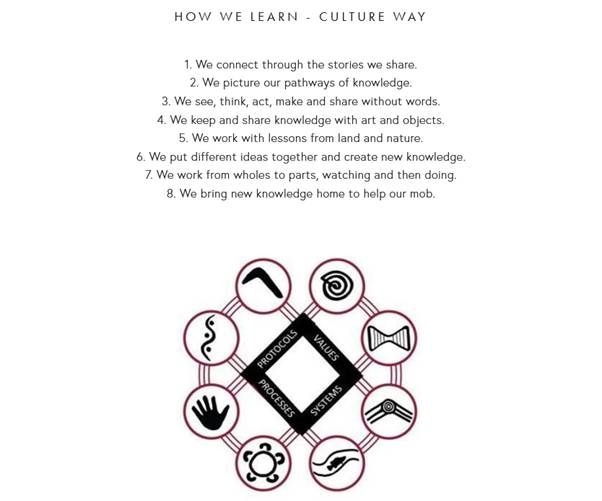More Detail on the 8 ways (First Nations)


DET's Bangamalanha Centre, 2021
The 8 ways framework is about identifying and integrating local First Nations
- values
- systems
- protocols
- processes
"...the element of 'story sharing' is now understood......in terms of Aboriginal yarning modalities, narrative as pedagogy, narrative as process, narrative as ethics/values, stored experience, cultural meaning-making, place-a significant is, and as dynamic frameworks for memory cognition.
The element of 'learning maps' is now understood......in terms of Aboriginal intellectual processes that can be visualised using metaphors grounded in culture and country. More people are using this in their planning and as a tool for communicating explicit quality criteria.
The elements of 'non-verbal pedagogy is now understood......in terms of Aboriginal ways of relating connecting to knowledge reflectively, critically, ancestrally and physically...... using this primaeval behavioural management and problematic knowledge.
The element of 'symbol/image' is now understood......as a visual metalanguage, the building blocks for memory and for maki g of meaning which is cross-cultural and dynamic......to understand and remember new concepts. Increasingly, it being understood more as a 'metaphor', with image is being created orally as well as visually in support of learning new concepts.
The elements of 'land links' is now understood......in terms of Aboriginal concepts place and country - a dynamic set of relationships containing vast schematic, knowledge systems and intellectual processes that can guide and enrich......
The element of 'non-linear' pedagogy is now understood......in terms of Aboriginal traditions of cultural innovation through the interaction of cultural system, which can be applied today to a more productive integrated community and......knowledge. It is also known as a way of approaching higher order by incorporating seemingly unrelated domains to create complex, real-life problems to be solved......by using holistic thinking and innovative processes.
The element of 'deconstruct/reconstruct' is now understood...... in terms of Aboriginal scaffolding methodologies that engage with whole processes and Texas, modelling and building upon......basic skills and identities and then transferring those successfully from familiar to unfamiliar contexts.
The element of 'community links' is now understood......in terms of Aboriginal relationships for both insiders and outsiders, and the centrality of these relationships to the development and acquisition of all knowledge. We know that any learning (or program, or policy) that fails to connect to the system of relationship will ultimately fail..."
DET's Bangamalanha Centre, 2021
The joining lines are as important as the pedagogies themselves. Values, protocols, systems and processes refer to the ways of valuing (axiology), ways of being (ontology - protocols are rules for how to be), ways of knowing (epistemology) and ways of doing (methodology). When you engage with Indigenous communities at this level, you truly have the potential to embed broad and deep Indigenous perspectives.
